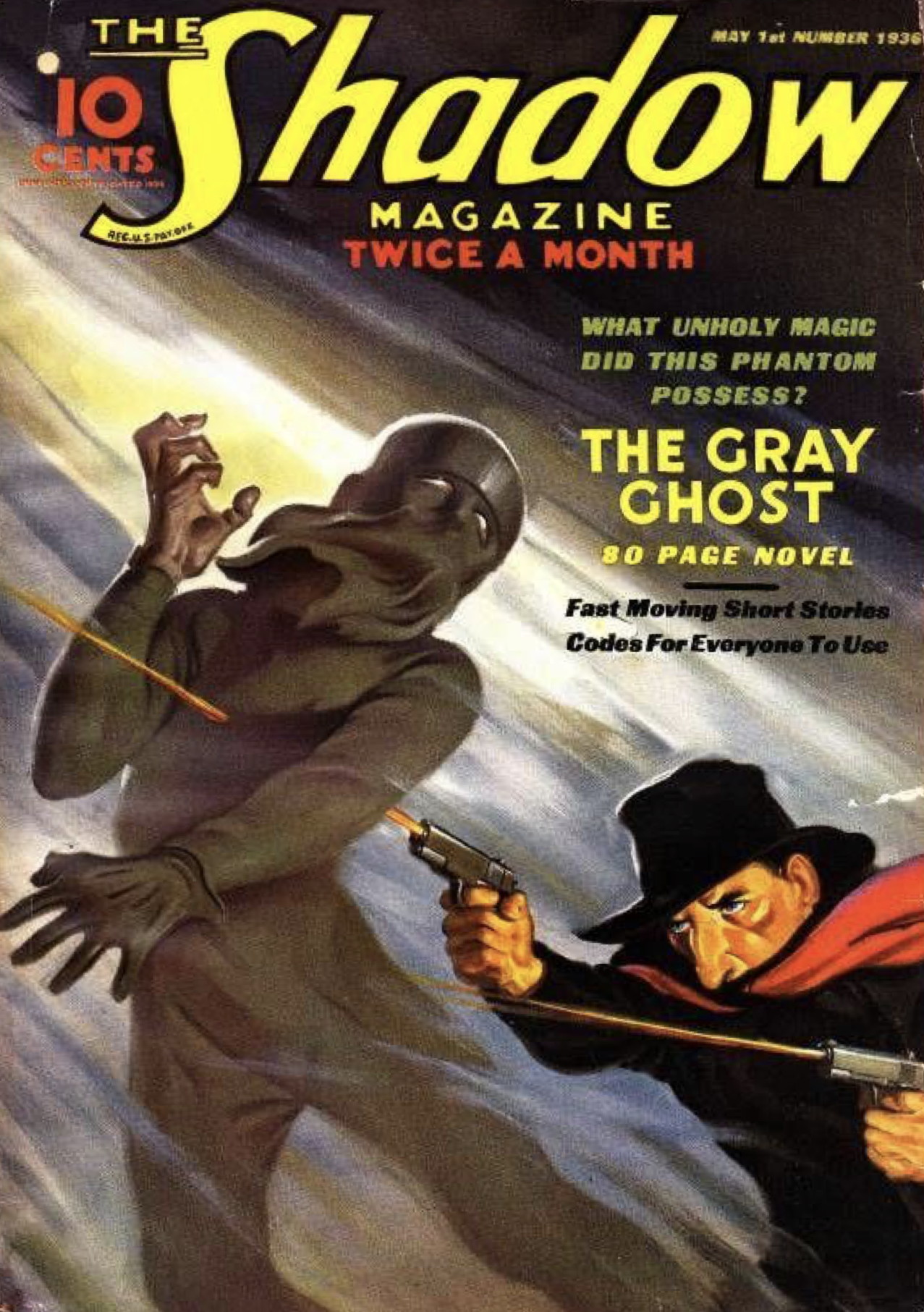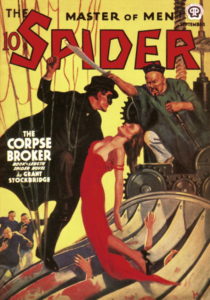
“The Corpse Broker” was originally published in the September 1939 issue of The Spider magazine. With terrible swiftness, the Master of the Green Death had struck. His victims lay in the streets, verdant-hued and ghastly — and the Underworld, which he had protected against all reprisal, ran riot in a Manhattan horror-holiday of looting and murder!
You go into a Spider novel expecting slam-bang action, weird menace and hundreds — if not thousands — of innocent victims of some fiendish mastermind. And this story delivers. It’s got everything you’re looking for. This is why you read The Spider pulps, and you won’t be disappointed. It’s a fun way to spend your free reading time.
The menace, this time around, is called the Green Death. That’s because victims of this strange malady gasp for breath, writhing in pain. And in death, a horrible discoloration spreads over their features… a ghastly green. No one knows what — or who — causes it. But the bizarre thing is that it only strikes down policemen. The criminals of New York are quick to take advantage of that fact. When police rush to the aid of those being robbed, they are struck down by the Green Death. That means that the entire Underworld is free to do pretty much what it wants. And that means total chaos for the city!
Our story opens
As our story opens, Richard Wentworth is on the run from the police. Yes, again. It seems they are always hounding him, and this story is no exception. Thirty policemen have died, and Wentworth has been blamed. We aren’t given the details, and they aren’t important. The important thing is that Wentworth hides down on the East Side, disguised as Casimir Belotti, an impoverished street musician.
Casimir Belotti and Garry Burke, a fellow street musician, head down to Broadway to see if they can earn some money from the theater crowd down there. But crime strikes! At the Paramount Theater, men smash the ticket window, slug the cashier and clean out the cage. The same thing has happened at the Astor, the Globe, the Mayfair, the Hollywood, the Capital… all the large movie theaters have been struck. Police corner the thugs, the hoodlums reach out empty clawing hands, 50 feet from the nearest policeman. Police grasp their throats. Their mouths wide open, gasping for air. They drop to the street, writhing in pain. They die; a horrible discoloration spreads over their features… a ghastly green.
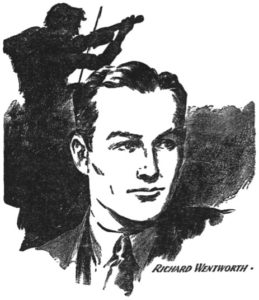
This was not the first green death. A week ago, a policeman had run to the aid of a woman being robbed. As he fell to the street gasping for breath, writhing in terrible convulsions. He died, his face a ghastly mottled green. The medical examiner had declared it a heart attack.
Two days later, a wealthy financier had been robbed in his own home. He set off a burglar alarm and when officers arrived they dropped, squirming in horrible agony. Again, it was pronounced heart attacks. But, tonight, more than a hundred police had been killed. This could not be explained as a hundred simultaneous heart failures.
Poor little Bobby
Ruth Hanley, with her 6-year-old son, Bobby, in her arms, fights back against the masked thugs. Wentworth comes to her aid, but she is mortally wounded. She identifies her assailant as Turk Gorman, one of Jigger Monahan‘s hired killers. Before she dies, she begs that Wentworth take care of young Bobby.
Wentworth takes young Bobby to a doctor. Dr. Hugo Schoenheit, an old German physician, was under a great obligation to Wentworth, and would do anything to repay the man who had once snatched him from the clutches of merciless killers. He leaves the boy there, then he returns to his Bowery tenement, still guised as Casimir Belotti.
There, he saves Garry Burke from thugs who are ready to kill him. Thankful, the man confesses he is really Jim Mack, a detective out to find The Spider at the direction of the new police commissioner Sanford Dane.
Wentworth’s good friend Stanley Kirkpatrick is no longer Police Commissioner. He is a bed-ridden invalid. In his place is acting commissioner Sanford Dane, who also believes The Spider is Richard Wentworth. Two months earlier in the July 1939 issue of the magazine, “The Spider and the Slaves of Hell,” Kirkpatrick had a heart attack. He’s still recuperating, here. But by the end of the year, in the December issue, Kirkpatrick would be back at work. But for now, Sandord Dane is in charge and he hates The Spider worse than Kirkpatrick ever did.
So now the Wentworth and Jim Mack will hopefully work together to solve the mystery of the strange deaths. Of course Commissioner Dane believes The Spider is behind it all, and so does Jim Mack. So Wentworth had better be careful!
Things look bleak for the law
As it typical in Spider stories, things go from bad to worse. By the next day, 150 policemen are dead. Utter lawlessness threatens to break out. Banks have been broken into and looted, hotels held up and their guests robbed. Wealthy citizens have been robbed in their homes. Wherever the police responded, they have died at the first sign of opposition. Gunmen go wild with blood lust — killing, slaughtering.
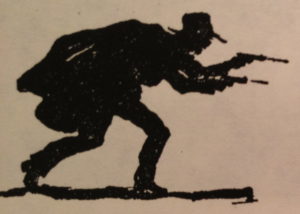
It’s interesting to note that Richard Wentworth can read lips. In a noisy bar, he watches two men and can tell the content of their conversation. He picks up a vital lead from that conversation. And in a later scene, we see that Wentworth understands and speaks Spanish. A talented guy!
When we see Wentworth switch to the disguise of The Spider, it is described as a hideous face.
The skin became sallow, puckered into deep, ugly wrinkles; the nose was beaked and predatory; lips disappeared entirely, until the mouth was nothing more than an almost colorless gash revealing stained, fang-like teeth. Into his eyes went drops that made them glisten; over his eyebrows tufts of shaggy hair. He adjusted a long, matted black wig.
Interesting to note that the teeth are fang-like, here. Not just snaggly, as in some stories.
After a week with no clues, Wentworth decides to use his Blinky McQuade disguise and seek information in the Underworld. Not a smart move, it seems. Readers are reminded that last time Wentworth appeared as Blinky McQuade, criminals had learned that he and The Spider were one. And Wentworth doesn’t know if any of them still lived.
Unfortunately, some of them do. Blinky is recognized by a man in a bar as The Spider. Blinky downs the scar-faced thug and makes his escape, but realizes that Blinky McQuade’s usefulness has ended. According to this story, the face “must never again be resurrected.” And never again, in The Spider chronology, did Wentworth use the Blinky McQuade disguise.
The end of Blinky McQuade
We’re told that Blinky McQuade’s career was finished, and the hideout is now a thing of the past. But he left a lot of damning evidence behind in that massive bed… the one with the make-up table hidden in the headboard. I just hate loose ends. That should have been taken care of.
So what’s behind all this Green Death business? Money, of course. Now, the Underworld has lost its fear of the police. Thieves, holdup men… all are certain they will not be apprehended. The Green Death mysteriously strikes down anyone who attempts to interfere with them. In return, they must hand over 10 percent of their take. Yes, the Master of the Green Death is taxing the Underworld for his assistance. If they refuse, they too become victims of the Green Death.
No one knows the identity of the hidden mastermind. Assisting him are the “blank-faced men.” These are mindless automatons created by some unholy operation. They suffer the tortures of a burning fire in their veins, a fire that can only be quenched by a regular injection of a greenish fluid from this fiend. They must obey! Hoo-boy, this is the definition of pulp!
There’s plenty of death, destruction and gore in the story. The dead lie in the streets. Crooks in their getaway cars ruthlessly ride over the prostrate victims. Yeck!
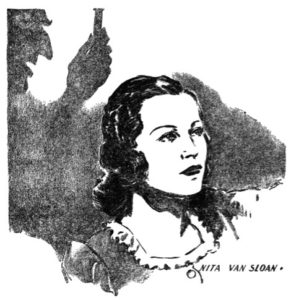
There is no sign of Ram Singh, Jackson, or Jenkyns in this tale. Only Nita and Kirkpatrick are regular characters to appear, and both are seen only briefly. We do see Catherine O’Keefe, a neighbor of Blinky McQuade’s. She’s a recurring character who has appeared in earlier stories. But now that the Blinky McQuade guise is being abandoned, will we see her in the future?
It is interesting to note, though, that Catherine O’Keefe apparently sees Wentworth as Casimir Belotti, not Blinky McQuade, and knows he is the same person. Nothing is made of it, but the man who appears to be Casimir Belotti escapes using the same route through Catherine’s window that McQuade always used. So I’m guessing that was intentional, so that she can appear in future stories assisting Belotti instead of McQuade.
There is an interesting sub-plot in this story. Hundreds of showgirls are kidnapped and put aboard a freighter bound for Buenos Aires and the infamous bordellos of Latin America. A trace of titillation, here. That was typical of author Norvell W. Page who liked to insert these little things into his stories. Of course, The Spider rescues them all, with the aide of 50 of the resilient young ladies.
In the end, Richard Wentworth discovers that the secret behind the Green Death is something in the water. That combined with excitement… action… any rush of physical activity… triggers the poison. Unfortunately, by the time Wentworth discovers this fact, he has drunk the water, himself. Now he must remain calm and cool… or die. Not easy to do and still defeat the madman and rescue Nita Van Sloan.
Nita Van Sloan and the death traps
Oh yes, Nita was captured… yet again. And she’s been placed in a death trap… yet again. And this one’s a doozy. At Flushing Meadows, site of the World’s Fair — now closed for the winter months — in the Hall of Machinery is a mowing machine, 20 feet high, with razor-sharp steel blades that revolve hungrily. Suspended above, ready to be dropped into the blades, more than a dozen men and woman, including Wentworth’s beloved, Nita Van Sloan.
This story does leave some unanswered questions that still nag at me. How is it that at our story’s climax, Wentworth exerts himself to save Nita and overcome the criminal mastermind, yet he doesn’t die? He was infected with the Green Death. Time and again, we see Wentworth start to exert himself, only to feel the clutch of the Green Death, yet at the end, he runs up the catwalks, frantically fights his way through… He runs, he climbs, he swings on his silk cord, with all his strength he urges his body, he strains every muscle to keep going. And he lives. Why? Did the drug wear off? We aren’t told. And I guess we aren’t supposed to ask. That’s the way pulp works, you know.
What about the blank-faced men? What was their fate? Last we saw them, they had turned mad, and gleefully watched men and women being slaughtered in that giant mowing machine. Will they continue to receive the potion that relieves the symptoms of the burning torture? Do any still live? Will they be cured? Again, we receive no answers.
And what of little Bobby Hanley? Wentworth promised his dying mother that he would care for him, but nothing further is said about it. It doesn’t seem like Wentworth to break his word to a dying woman. Hmmm…
As it typical in many of these pulp stories, the fiendish poisons just appear from nowhere. How the gangsters obtain them, how they were created and by whom, these things are never explored. They just got them… and use them!
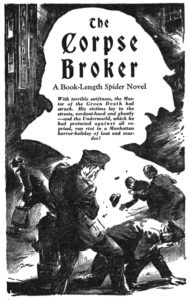
Also typically, The Spider is caught in a series of misunderstandings. Since he is present when the Green Death strikes, he is blamed. This is a common theme that runs through The Spider stories. The injustice of it is intended to inflame readers, and it works.
Inept government officials
Another common thread running through these stories is that government just doesn’t work. Citizens go to the police with information which could help them solve a case, but they ignore that information because they have their own agenda. They interpret what they hear in ways that fit their preconceived ideas. Once again, police fail the city they are supposed to protect. This theme is a recurring one in The Spider stories.
But sometimes, the sheer repetition of it seems unbelievable. Several times, even within a single story, The Spider warns the police of mass murders, they ignore him, it turns out he’s right, and yet the next time he warns them of mass murders, again they ignore him. It almost is illogical how pig-headed the police are portrayed in these stories.
And speaking of the police, their behavior here is outrageous. In one scene, Wentworth, disguised as a non-descript middle-aged man, and Dr. Schoenheit leave the doctor’s apartment. Twenty, 30 policemen lay in wait for two men they don’t know, then open up with their guns without warning. They are not shooting at The Spider… they are just shooting at a middle-aged man and a doctor. No explanation of why they wouldn’t try to take them alive. Strange…
Although the title of this story was “The Corpse Broker,” there was never any reference to it in the entire story. The explanation probably lies in the fact that the original title of the story was “Clutch of the Green Death.” And the term “Green Death” was used extensively throughout the tale. The change of title was an editorial decision, and one which may forever remain unexplained.
This is the last Spider story written by Wayne Rogers. He wrote 11 of the 118 Spider pulp adventures. His first was “Slaves of the Black Monarch” in the August 1937 issue. Among his other pulp works were nine Operator No. 5 pulp stories, also one of the Popular Publications. He also wrote for the stable of Popular’s weird menace pulps, including Dime Mystery Magazine, Terror Tales, and Horror Stories. He wrote for other publishing houses, as well, including Ace Magazines with Secret Agent X.
For his Spider swan song, Wayne Rogers did a great job, creating a really fun story. I liked it a lot, plot holes notwithstanding. I’m sure you will too!


